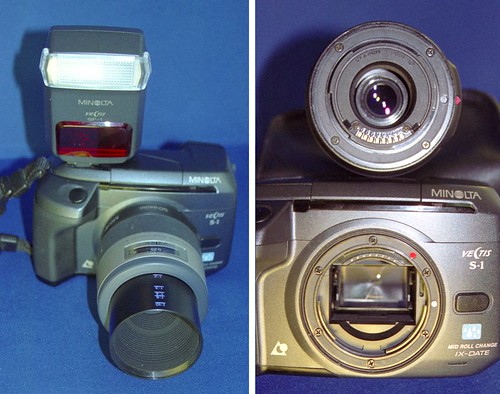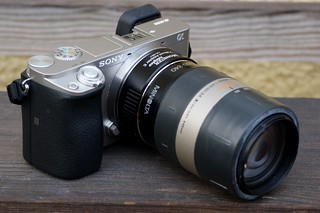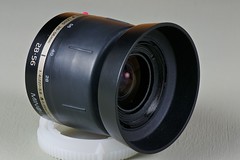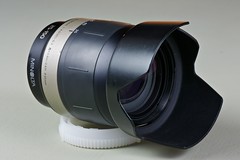Difference between revisions of "Minolta V mount"
m |
m (→V lenses are for APS film format, but are they ideal for digital re-use?: cat ext.) |
||
| (24 intermediate revisions by 3 users not shown) | |||
| Line 1: | Line 1: | ||
{{Flickr_image | {{Flickr_image | ||
| − | |image_source= http://www.flickr.com/photos/89864432@N00/385038416/in/pool- | + | |image_source= https://www.flickr.com/photos/chantalrene/31546045254/in/pool-camerawiki/ |
| + | |image= https://live.staticflickr.com/434/31546045254_c48b96bfe0_z.jpg | ||
| + | |image_align= right | ||
| + | |image_text=[[Minolta RD-3000]] w/ system flash & several system lenses. The mounted lens is a 17mm wide-angle lens. | ||
| + | |image_by= René Maly | ||
| + | |image_rights= with permission | ||
| + | }} | ||
| + | {{Flickr_image | ||
| + | |image_source= http://www.flickr.com/photos/89864432@N00/385038416/in/pool-camerawiki/ | ||
|image= http://farm1.static.flickr.com/159/385038416_0511632dc9.jpg | |image= http://farm1.static.flickr.com/159/385038416_0511632dc9.jpg | ||
| − | |image_align= | + | |image_align= left |
| − | |image_text= Minolta was the only camera maker that | + | |image_text=[[Minolta Vectis S-1]] with system flash & system lens, (left image) and<br/>the bayonets, male bayonet on lens, female bayonet in body (right image). |
| + | |image_by= Uwe Kulick | ||
| + | |image_rights= with permission | ||
| + | }}{{br}} | ||
| + | |||
| + | [[Minolta]] was the only camera maker that created a new [[autofocus]] SLR [[camera system]] with a complete set of new lenses for the [[APS film]] system. Only three camera models got the lens bayonet that fits for these precious lenses: The [[Minolta Vectis S-1]], the [[Minolta Vectis S-100]], and the digital SLR [[Minolta RD-3000]]. All automatic control signals are given electronically to the lens barrel. Camera body and lens, both sides have the necessary electrical contacts. The image shows the Minolta Vectis S-1 with the 1:3.5/50mm macro V-lens. The system flash SF-1 bears a macro diffusor, and the lens is focused to nearest distance (23mm, magnification 1:2) . | ||
| + | |||
| + | The RD 3000's ½" [[CCD]] sensors with 6.4×4.8mm image area usually would mean a [[crop factor]] of 5.4 compared to [[35mm]] format (full frame), whilst the APS format means 1.5 crop. The very compromise of the RD3000's two sensors is to divide incoming light, one share going to a green-sensor, the other half to a blue&red-matrix sensor. In addition, inside the camera the incoming light-stream is optically converted to simulate an [[APS-C]] size sensor, virtually reducing crop to APS-film's 1.5, but also effective aperture, meaning almost double depth-of-field of this digital camera system. The ''35mm focal-length equivalents'' in the table below are given for crop 1.5. | ||
| + | |||
| + | ==The system lenses for Minolta's Vectis S-1, Vectis S-100, and Dimâge RD-3000== | ||
| + | {|cellspacing=0 border=1 | ||
| + | ! V lens !! description !! image !! digital re‑use** | ||
| + | |- | ||
| + | ||V 17mm f/3.5 RD | ||
| + | ||A super wide-angle lens (35mm film equivalent: approx. 26mm) | ||
| + | || | ||
| + | || possible | ||
| + | |- | ||
| + | ||V 22 - 80 mm f4 - 5.6 | ||
| + | ||A standard type 3.6X zoom lens that covers wide angle to telephoto range, compact and lightweight (35mm film equivalent: approx. 34 - 123mm) | ||
| + | || | ||
| + | {{Flickr_image | ||
| + | |image_source= https://www.flickr.com/photos/alf_sigaro/15247192032/in/pool-camerawiki/ | ||
| + | |image= https://live.staticflickr.com/5586/15247192032_ffab9118ca_m_d.jpg | ||
| + | |image_align= left | ||
| + | |image_text= | ||
| + | |image_by= Alf Sigaro | ||
| + | |image_rights= nc | ||
| + | }} | ||
| + | || possible | ||
| + | |- | ||
| + | ||V 28 - 56 mm f4 - 5.6 | ||
| + | ||A standard type 2.0X zoom lens (35mm film equivalent: approx. 48 - 86mm) | ||
| + | || | ||
| + | {{Flickr_image | ||
| + | |image_source= http://www.flickr.com/photos/mikeladell/3967324194/in/pool-camerawiki | ||
| + | |image= http://farm4.static.flickr.com/3469/3967324194_397b4790f0_m.jpg | ||
| + | |image_align= left | ||
| + | |image_text= | ||
| + | |image_by= Mikel Adell | ||
| + | |image_rights= wp | ||
| + | }} | ||
| + | || impossible | ||
| + | |- | ||
| + | ||V 80‑240mm f4.5‑5.6 APO | ||
| + | ||An apochromatic (=highly colorcorrected) high-performance 3.0X tele zoom lens (35 mm film equivalent: approx. 123 - 370mm) | ||
| + | || | ||
| + | {{Flickr_image | ||
| + | |image_source= https://www.flickr.com/photos/alf_sigaro/15072701180/in/pool-camerawiki/ | ||
| + | |image= https://live.staticflickr.com/3919/15072701180_f5a740c4b3_m_d.jpg | ||
| + | |image_align= left | ||
| + | |image_text= | ||
| + | |image_by= Alf Sigaro | ||
| + | |image_rights= nc | ||
| + | }} | ||
| + | || recommended | ||
| + | |- | ||
| + | ||V 50 mm f3.5 MACRO | ||
| + | ||A macro lens with focus from infinity to a 1:2 magnification ratio (35 mm film equivalent: approx. 77mm) | ||
| + | || | ||
| + | {{Flickr_image | ||
| + | |image_source= https://www.flickr.com/photos/alf_sigaro/15083081019/in/pool-camerawiki/ | ||
| + | |image= https://live.staticflickr.com/5570/15083081019_b2d59bdf01_m_d.jpg | ||
| + | |image_align= left | ||
| + | |image_text= | ||
| + | |image_by= Alf Sigaro | ||
| + | |image_rights= nc | ||
| + | }} | ||
| + | || recommended | ||
| + | |- | ||
| + | |colspan=4|''The following lenses lenses can be attached to the [[Minolta RD-3000]], but may not perform to 100% of their capabilities.'' | ||
| + | |- | ||
| + | ||V 56-170mm f/4.5-5.6 | ||
| + | || | ||
| + | || | ||
| + | {{Flickr_image | ||
| + | |image_source= https://www.flickr.com/photos/alf_sigaro/15072654209/in/pool-camerawiki/ | ||
| + | |image= https://live.staticflickr.com/5553/15072654209_d932984556_m_d.jpg | ||
| + | |image_align= left | ||
| + | |image_text= | ||
| + | |image_by= Alf Sigaro | ||
| + | |image_rights= nc | ||
| + | }} | ||
| + | || possible | ||
| + | |- | ||
| + | ||V Reflex 400mm f/8 | ||
| + | || | ||
| + | || | ||
| + | {{Flickr_image | ||
| + | |image_source= https://www.flickr.com/photos/chantalrene/31809759197/in/pool-camerawiki | ||
| + | |image= https://live.staticflickr.com/4805/31809759197_dd56699b3b_m.jpg | ||
| + | |image_align= left | ||
| + | |image_text= | ||
| + | |image_by= René Maly | ||
| + | |image_rights= wp | ||
| + | }} | ||
| + | || possible | ||
| + | |- | ||
| + | ||V 25-150mm f/4.5-6.3 | ||
| + | || | ||
| + | || | ||
| + | {{Flickr_image | ||
| + | |image_source= http://www.flickr.com/photos/mikeladell/3967325214/in/pool-camerawiki | ||
| + | |image= http://farm4.static.flickr.com/3437/3967325214_bd9f7e8556_m.jpg | ||
| + | |image_align= left | ||
| + | |image_text= | ||
| + | |image_by= Mikel Adell | ||
| + | |image_rights= wp | ||
}} | }} | ||
| + | || impossible | ||
| + | |} | ||
| + | For all lenses listed above: | ||
| + | - Effective aperture range: f/6.7 - 22 | ||
| + | - Focal length: approx. 1.5 times longer when compared to 35mm film usage. | ||
| + | <div class = "floatleft plainlinks" style="margin:0px 20px 0px 0px;"> | ||
| + | </div> | ||
| + | |||
| + | ** ''digital re-use'' on [[Sony NEX]] and its successors | ||
| + | Sony A5x00 & A6x00 is possible by means of the | ||
| + | ''MonsterAdapter LA-VE1''<br/> | ||
| + | This kind of re-use is recommended only for two of the | ||
| + | lenses, the APO tele zoom lens and the 50mm Macro lens, | ||
| + | since both have a manual-focusing ring that works | ||
| + | sufficiently with this adapter. It supports manual focus | ||
| + | and automatic aperture. | ||
| + | |||
| + | {{Flickr_image | ||
| + | |image_source= https://www.flickr.com/photos/uwe_kulick/50901383423/in/pool-camerawiki/ | ||
| + | |image= https://live.staticflickr.com/65535/50901383423_dd97f6ed70_n_d.jpg | ||
| + | |image_align= right | ||
| + | |image_text= The APO lens 80-240mm, adapted to a ''Sony Alpha 6000''<br/>by means of MonsterAdapter LA-VE1 | ||
| + | |image_by= Uwe Kulick | ||
| + | |image_rights= wp | ||
| + | }} | ||
| + | ===V lenses are for APS film format, but are they ideal for digital re-use?=== | ||
| + | The most [[DSLR]] cameras and mirrorless [[system camera]]s rely on imaging [[sensor]]s of ''APS-C'' format. Thus all Minolta V Lenses should be ideal partners for the modern digital way of photography, but there was only one adapter available, branded ''MonsterAdapter'', type name is ''LA-VE1''. Thus re-use is only possible on [[Sony NEX]] cameras and its successors. Only the re-use of the tele zoom 80-240, a nicely sharp apochromatic lens, and the re-use of the 50mm macro - Minolta was a real good maker of 50mm macro lenses - only for owners of both lenses who also like them, the Adapter can be recommended. | ||
| + | |||
| + | Surprisingly, in 2022 another adapter that supports autofocus followed, despite of such a specialty product's limited market, when we take a view onto the sales of the MonsterAdapter LA-VE1. Production of one small series after the other seems to make it possible. So now it's there, the LA-VE2. It makes more V-lenses reusable in [[Sony E-mount|Sony's e-mount]]. | ||
| − | [[Category:Minolta]] | + | [[Category:Minolta|V mount]] |
| + | [[Category:Minolta V mount| ]] | ||
[[Category:lens mounts]] | [[Category:lens mounts]] | ||
[[Category:Japanese APS]] | [[Category:Japanese APS]] | ||
Latest revision as of 20:12, 8 February 2024

|
| Minolta RD-3000 w/ system flash & several system lenses. The mounted lens is a 17mm wide-angle lens. image by René Maly (Image rights) |

|
| Minolta Vectis S-1 with system flash & system lens, (left image) and the bayonets, male bayonet on lens, female bayonet in body (right image). image by Uwe Kulick (Image rights) |
Minolta was the only camera maker that created a new autofocus SLR camera system with a complete set of new lenses for the APS film system. Only three camera models got the lens bayonet that fits for these precious lenses: The Minolta Vectis S-1, the Minolta Vectis S-100, and the digital SLR Minolta RD-3000. All automatic control signals are given electronically to the lens barrel. Camera body and lens, both sides have the necessary electrical contacts. The image shows the Minolta Vectis S-1 with the 1:3.5/50mm macro V-lens. The system flash SF-1 bears a macro diffusor, and the lens is focused to nearest distance (23mm, magnification 1:2) .
The RD 3000's ½" CCD sensors with 6.4×4.8mm image area usually would mean a crop factor of 5.4 compared to 35mm format (full frame), whilst the APS format means 1.5 crop. The very compromise of the RD3000's two sensors is to divide incoming light, one share going to a green-sensor, the other half to a blue&red-matrix sensor. In addition, inside the camera the incoming light-stream is optically converted to simulate an APS-C size sensor, virtually reducing crop to APS-film's 1.5, but also effective aperture, meaning almost double depth-of-field of this digital camera system. The 35mm focal-length equivalents in the table below are given for crop 1.5.
The system lenses for Minolta's Vectis S-1, Vectis S-100, and Dimâge RD-3000
| V lens | description | image | digital re‑use** | ||
|---|---|---|---|---|---|
| V 17mm f/3.5 RD | A super wide-angle lens (35mm film equivalent: approx. 26mm) | possible | |||
| V 22 - 80 mm f4 - 5.6 | A standard type 3.6X zoom lens that covers wide angle to telephoto range, compact and lightweight (35mm film equivalent: approx. 34 - 123mm) |
|
possible | ||
| V 28 - 56 mm f4 - 5.6 | A standard type 2.0X zoom lens (35mm film equivalent: approx. 48 - 86mm) |
|
impossible | ||
| V 80‑240mm f4.5‑5.6 APO | An apochromatic (=highly colorcorrected) high-performance 3.0X tele zoom lens (35 mm film equivalent: approx. 123 - 370mm) |
|
recommended | ||
| V 50 mm f3.5 MACRO | A macro lens with focus from infinity to a 1:2 magnification ratio (35 mm film equivalent: approx. 77mm) |
|
recommended | ||
| The following lenses lenses can be attached to the Minolta RD-3000, but may not perform to 100% of their capabilities. | |||||
| V 56-170mm f/4.5-5.6 |
|
possible | |||
| V Reflex 400mm f/8 |
|
possible | |||
| V 25-150mm f/4.5-6.3 |
|
impossible | |||
For all lenses listed above: - Effective aperture range: f/6.7 - 22 - Focal length: approx. 1.5 times longer when compared to 35mm film usage.
** digital re-use on Sony NEX and its successors Sony A5x00 & A6x00 is possible by means of the MonsterAdapter LA-VE1
This kind of re-use is recommended only for two of the lenses, the APO tele zoom lens and the 50mm Macro lens, since both have a manual-focusing ring that works sufficiently with this adapter. It supports manual focus and automatic aperture.

|
| The APO lens 80-240mm, adapted to a Sony Alpha 6000 by means of MonsterAdapter LA-VE1 image by Uwe Kulick (Image rights) |
V lenses are for APS film format, but are they ideal for digital re-use?
The most DSLR cameras and mirrorless system cameras rely on imaging sensors of APS-C format. Thus all Minolta V Lenses should be ideal partners for the modern digital way of photography, but there was only one adapter available, branded MonsterAdapter, type name is LA-VE1. Thus re-use is only possible on Sony NEX cameras and its successors. Only the re-use of the tele zoom 80-240, a nicely sharp apochromatic lens, and the re-use of the 50mm macro - Minolta was a real good maker of 50mm macro lenses - only for owners of both lenses who also like them, the Adapter can be recommended.
Surprisingly, in 2022 another adapter that supports autofocus followed, despite of such a specialty product's limited market, when we take a view onto the sales of the MonsterAdapter LA-VE1. Production of one small series after the other seems to make it possible. So now it's there, the LA-VE2. It makes more V-lenses reusable in Sony's e-mount.






